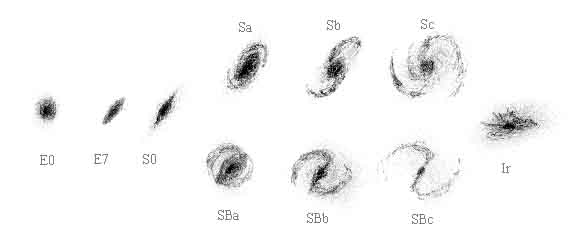

When we look at a random collection of galaxies, it seems that the spirals are most common. But this is a selection effect, resulting from our home position in the local group of galaxies, a loose aggregation of spirals and irregular types and the "near by" Virgo cluster, which also contains a large fraction of spirals. On the large scale, dense clusters of thousands of predominant elliptical and S0 galaxies change these statistics dramatically.
Elliptical galaxies are the most common type of galaxies. Roughly 60% are ellipticals, 20% are spirals and 20% are irregulars. Ellipticals contain very little gas and dust. They only possess very old population II stars, because star formation needs gas and dust to continue. In opposition to the disk-type galaxies there is no rapid rotation in elliptical galaxies. The classification sequence goes from E0, where the projected appearance of the the galaxy appears perfect circular, to E7, where the form is long and elongated. Well known galaxies of this type are the companions (M32, E0) and (NGC 205, E6) of the Andromeda Galaxy (M31) and M87 the dominant galaxy of the Virgo cluster (E0). These examples show, that elliptical galaxies span the widest range of sizes and masses. The observed apparent ellipticity results from the projection of the true ellipsoid onto the celestial sphere. Therefore it is hard to tell, what the real form of an elliptical galaxy in space is.
S0 galaxies are closely related to spirals. They have flat, rotating disks, central bulges, no, or very little gas and no spiral arms and they contain only old stellar populations.
Spiral galaxies are characterized by flat, rotating disks, central bulges, moderate amounts of gas and as the name implies, spiral arms. The central region contains old red (Pop II) stars, while the winding spiral arms are glowing with young blue stars (Pop I). They are further subdivided according to their central bulges and the appearance of the spiral arms. Sa galaxies have the largest bulges, tightly wound arms and not much dust and gas. Example M104. Sc galaxies have small bulges, loosely wound arms and a large amount of gas. A famous example is the "Whirlpool Galaxy", M51. Sb types are intermediate between these. It is believed, that our own galaxy is of type Sb, as is M31, the great Andromeda galaxy.
Barred spirals have a more or less pronounced central bar. As the normal spirals they are classified as SBa to SBc. The spiral arms do not start tangentially at the bulge, instead they are connected to the end of a central bar. Today we know that barred spirals are not a special class of galaxies, but a short-lived phase in the lifetime of nearly every spiral galaxy. Examples for fine barred spirals are M109 and NGC2903.
Spirals in general look very different when they are viewed edge-on, e.g. M104, and it is hard to distinguish normal and barred spirals in this special case.
Irregular galaxies have no obvious structure and are classified as Ir. They contain large amounts of gas and dust, and star formation is dominant feature of this class.
It should be emphasized, that this classification scheme relies on form
only. It is not an evolutionary sequence. Spirals can not survive
in dense clusters of galaxies, and the classification often depends on
the spectral range where the recording medium has it's maximum sensitivity.
For instance irregular types appear often in a different form if a blue
sensitive plate is compared with one which is sensitive in the red part
of the spectrum.
The de Vaucouleurs System
Defines a two-parameter continuum at each point along the S0-Sd sequence.
The Morgan System
Extends to three classification dimensions:
Low Surface Brightness Galaxies
A recently detected new class of galaxies. They are so dim that only
sophisticated detection techniques can bring them to visibility.
Many of them are monsters if they are compared to normal galaxies.
For example Mallin 1 has ten times the size of our Milky Way
Galaxy.
More images of galaxies can be found on my pages about
Comments welcome, contact:
